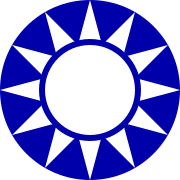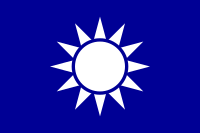Kuomintang 中國國民黨 Zhōngguó Guómíndǎng Chungkuo Kuomintang Chūgoku Kokumintō | |
|---|---|
 | |
| Abbreviation | KMT |
| Premier | Sun Yat-sen (eternal) |
| Chairman | Wang Jingwei (1939–1944) Chen Gongbo (1944–1945) |
| Founded | 28 November 1939 |
| Dissolved | 16 August 1945 |
| Split from | Kuomintang[a] |
| Headquarters | Nanjing, Republic of China |
| Armed wing | Chinese Collaborationist Army |
| Ideology | |
| Political position | Far-right[2] |
| International affiliation | Greater East Asia Co-Prosperity Sphere |
| Colours | Blue |
| Anthem | "Three Principles of the People" |
| Party flag | |
 | |
^ a: Claimed to be the legitimate Kuomintang in contrast to the Chiang Kai-shek-led government in Chungking | |
During the Second Sino-Japanese War, Wang Jingwei, former Premier of the Republic of China and Vice Director-General of the Kuomintang (Chinese Nationalist Party), split from the party in 1939 and established a new Kuomintang in Nanking. Wang, who collaborated with the Japanese, intended to distance the new party from the Kuomintang led by Chiang Kai-shek in Chungking. It was the sole ruling party of the Wang Jingwei regime, a puppet state of the Empire of Japan.
Officially still the "Kuomintang" (traditional Chinese: 中國國民黨; simplified Chinese: 中国国民党; pinyin: Zhōngguó Guómíndǎng), it was also referred to as "Wang's Pseudo-Kuomintang" or "Wang's Puppet Kuomintang" (traditional Chinese: 汪偽國民黨; simplified Chinese: 汪伪国民党; pinyin: Wāng wěi guómíndǎng).[3][4]
- ^ Larsen, Stein Ugelvik (ed.). Fascism Outside of Europe. New York: Columbia University Press, 2001. ISBN 0-88033-988-8. p. 255.
- ^ Cite error: The named reference
Jiangsu 1was invoked but never defined (see the help page). - ^ "汪伪国民政府始末(五)" [History of Wang's Puppet Regime (5)]. 抗日战争纪念网. Retrieved 27 January 2023.
- ^ "汪偽檔案" [Papers of Wang's puppet government]. terms.naer.edu.tw. Retrieved 27 January 2023.